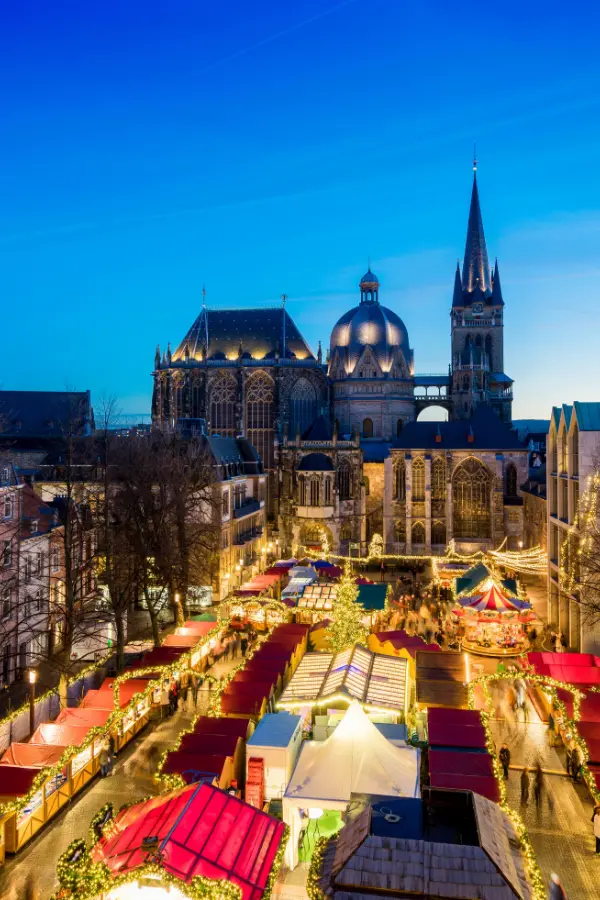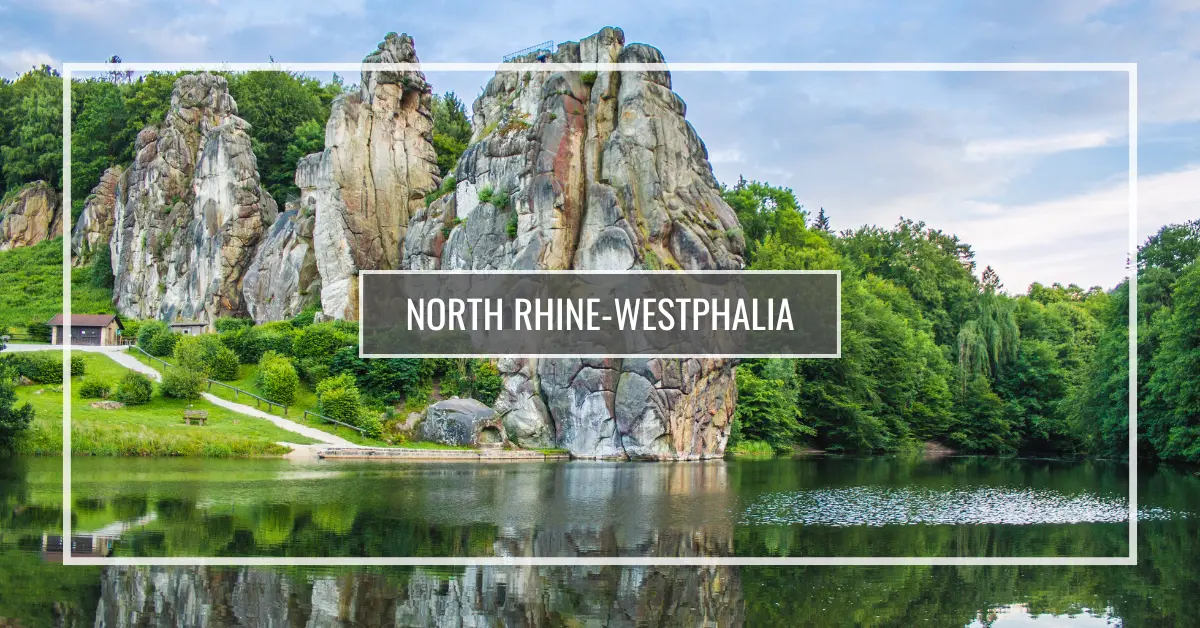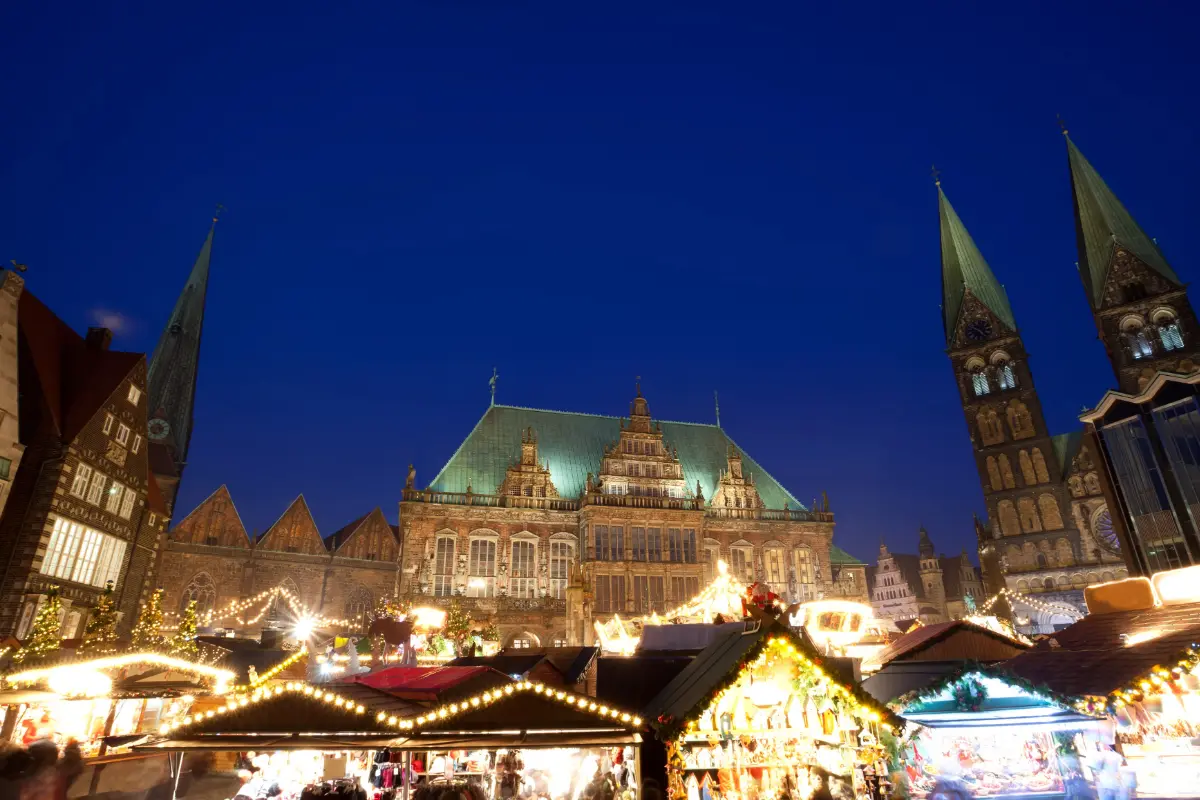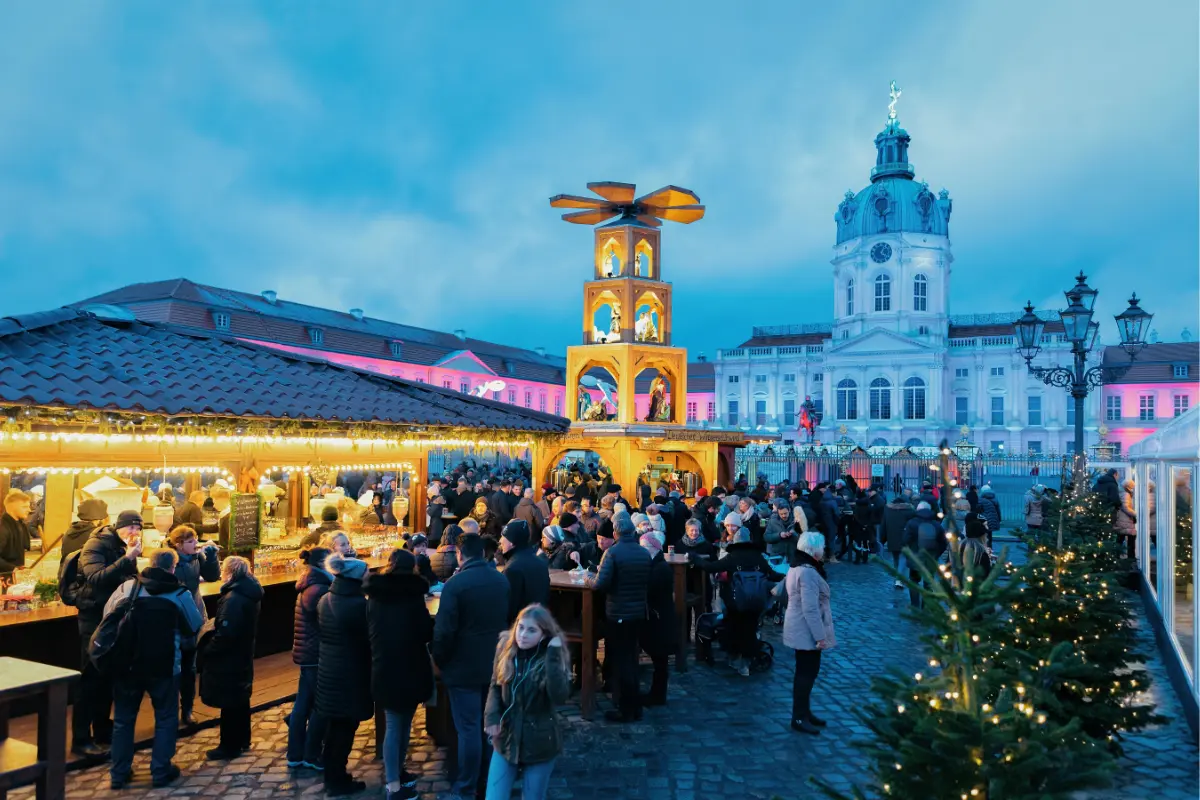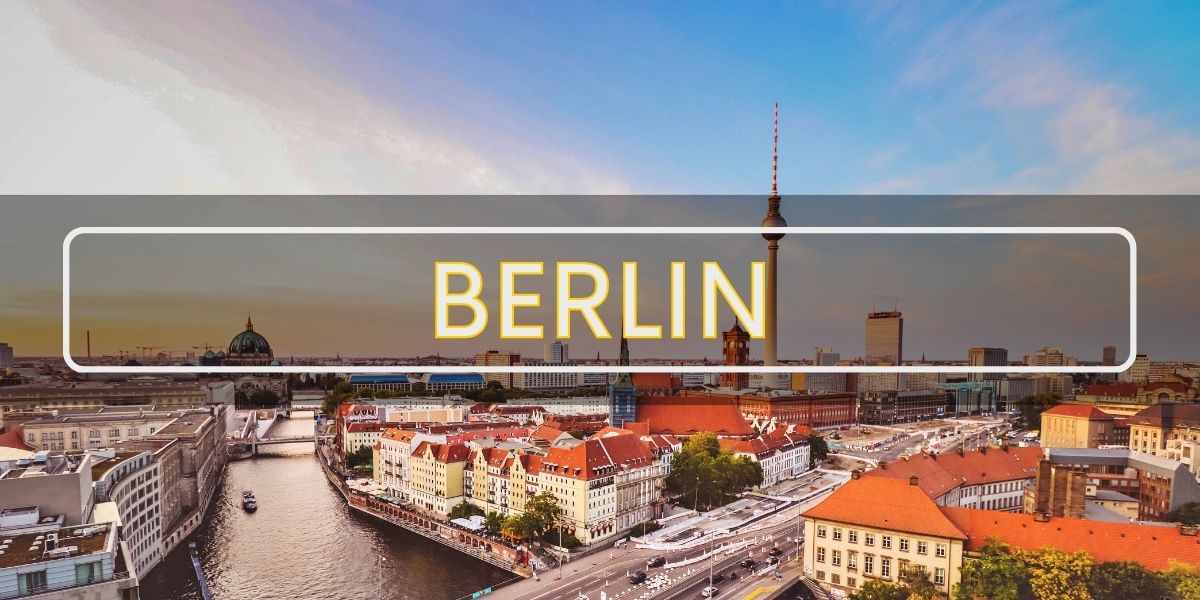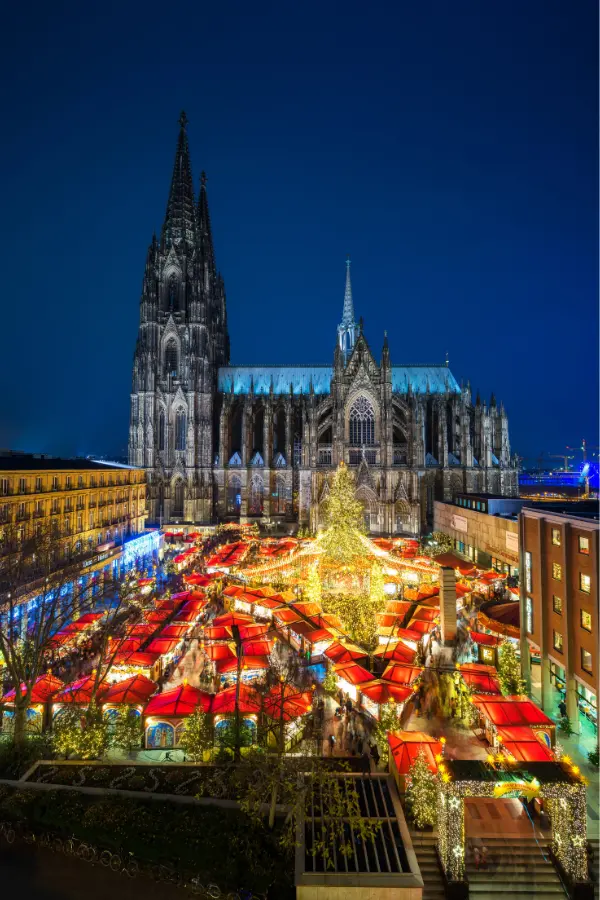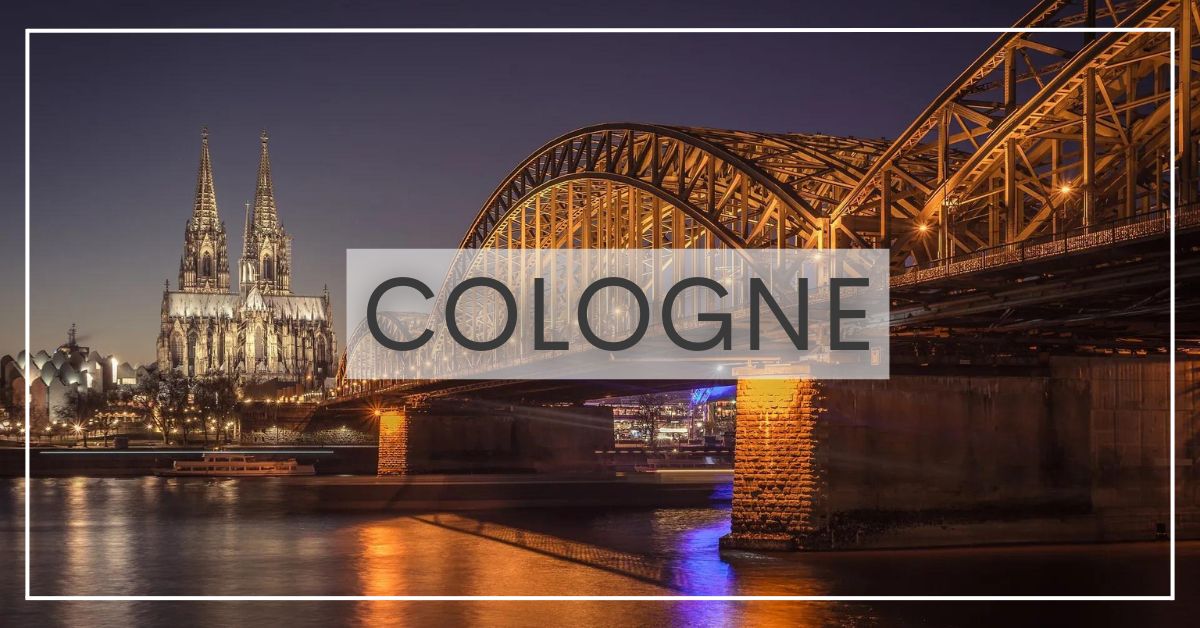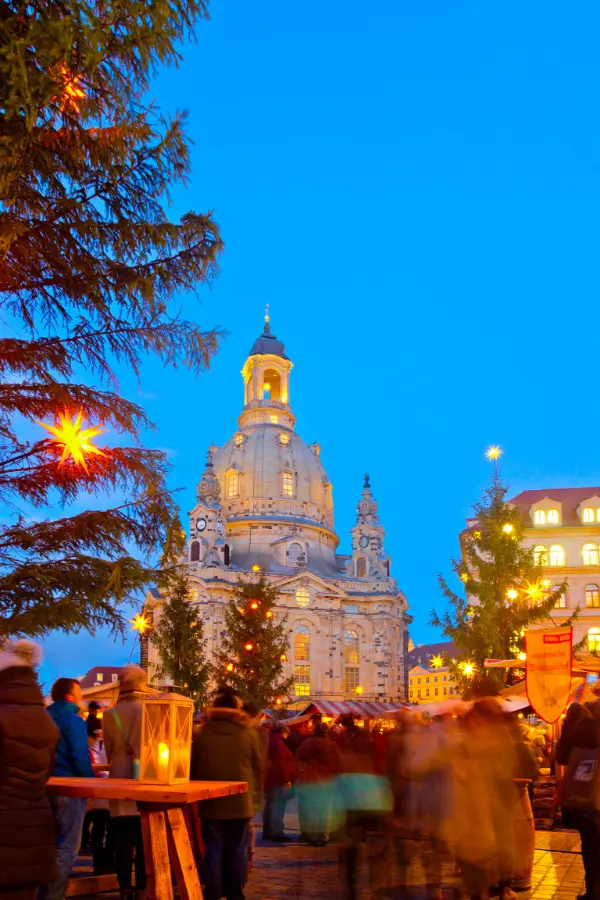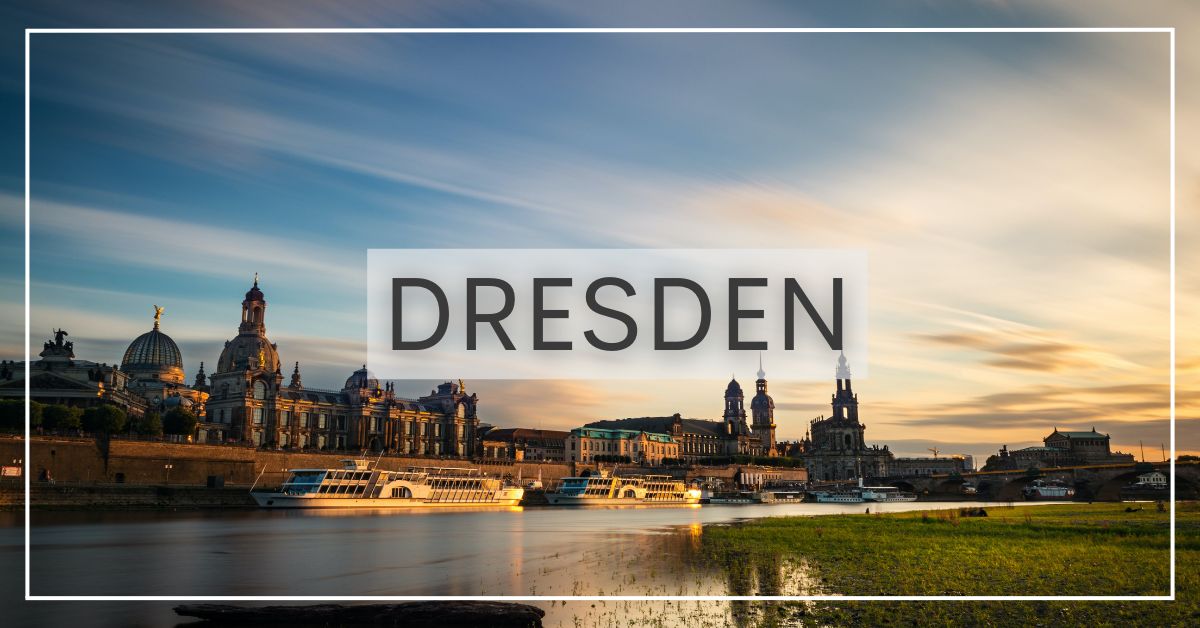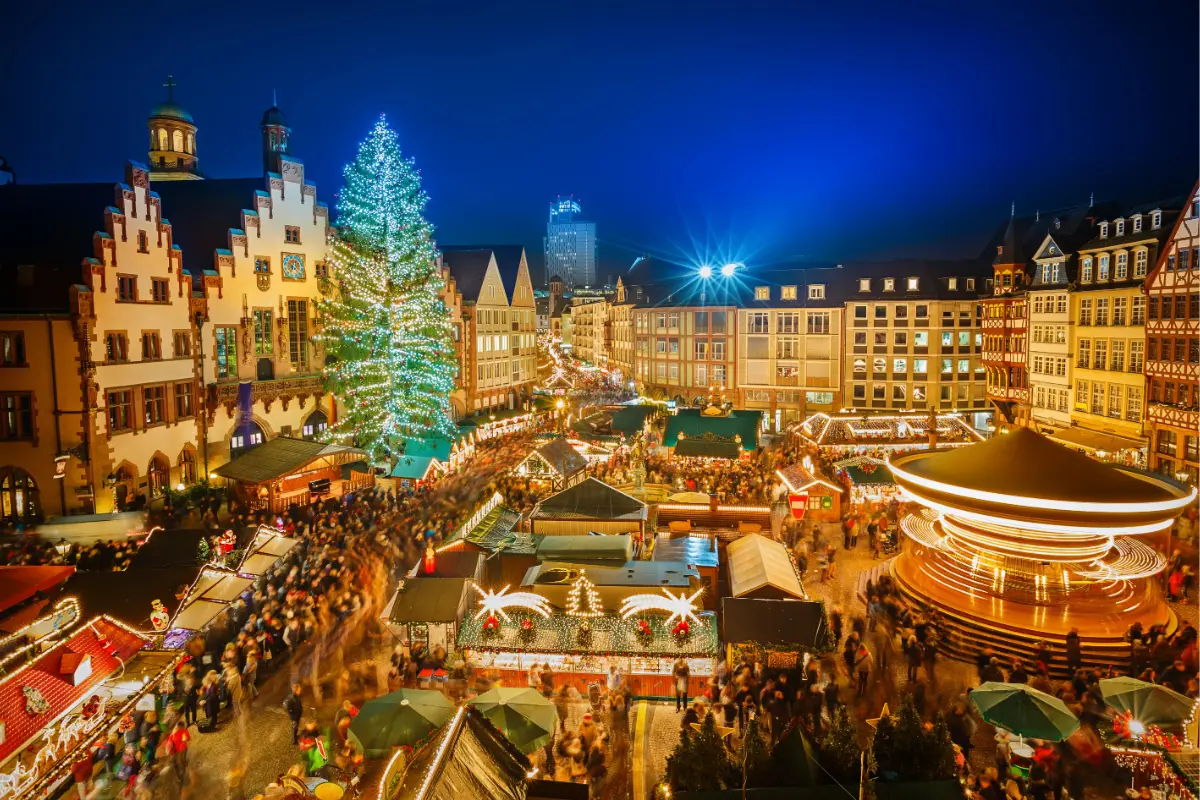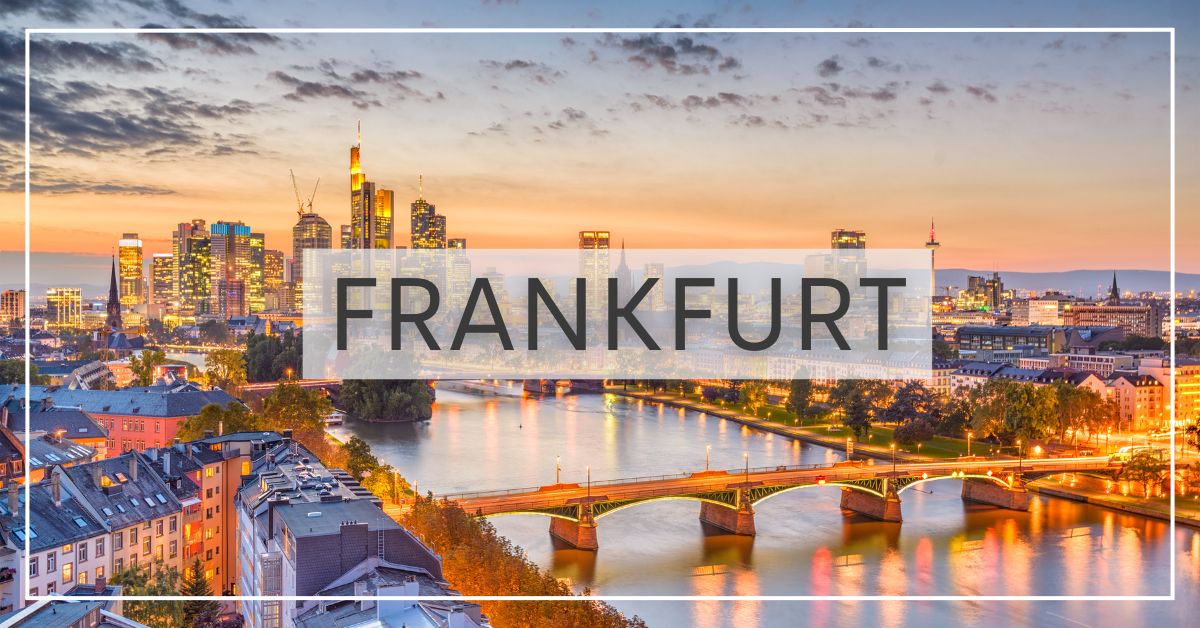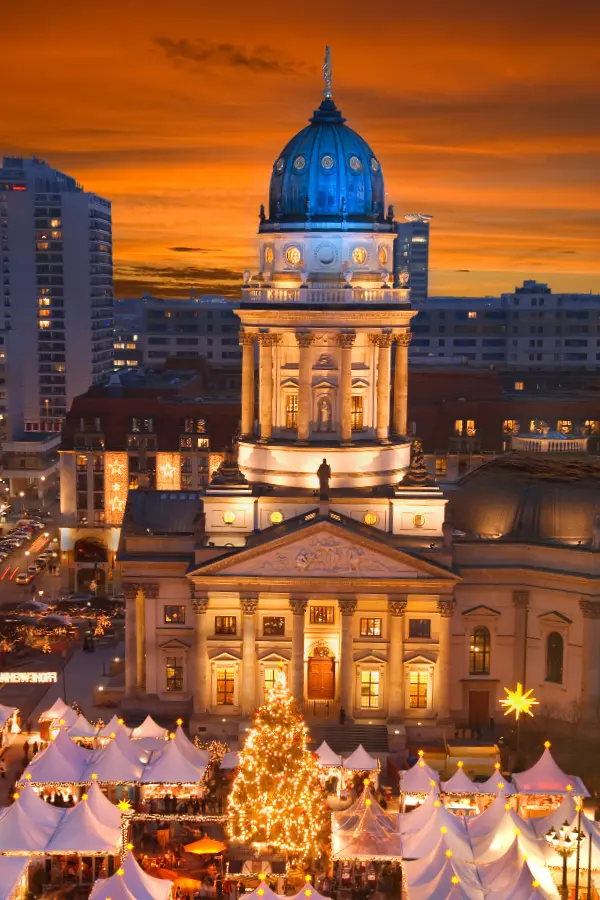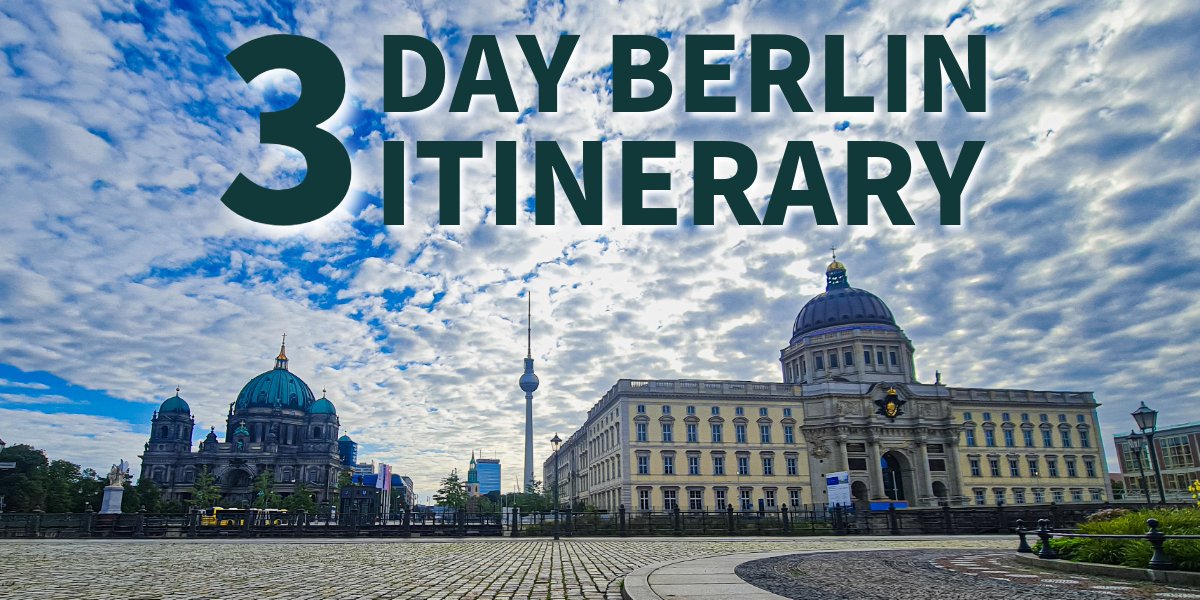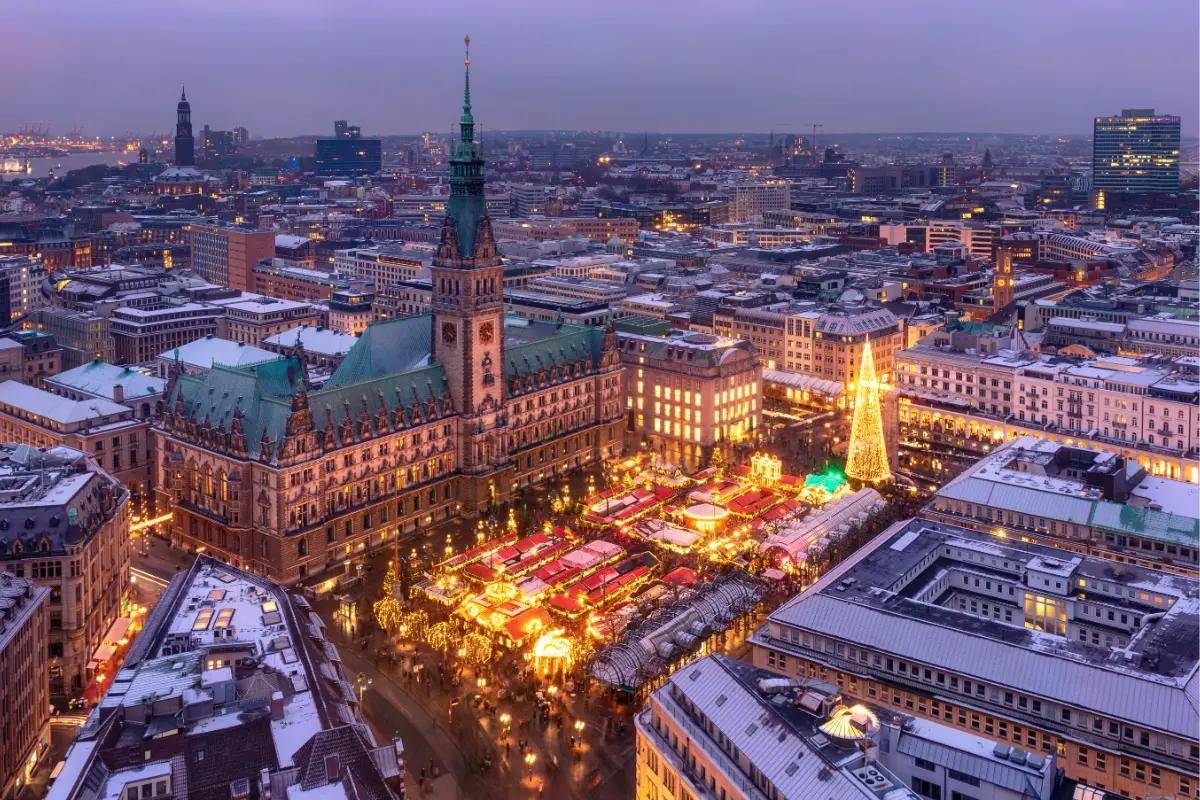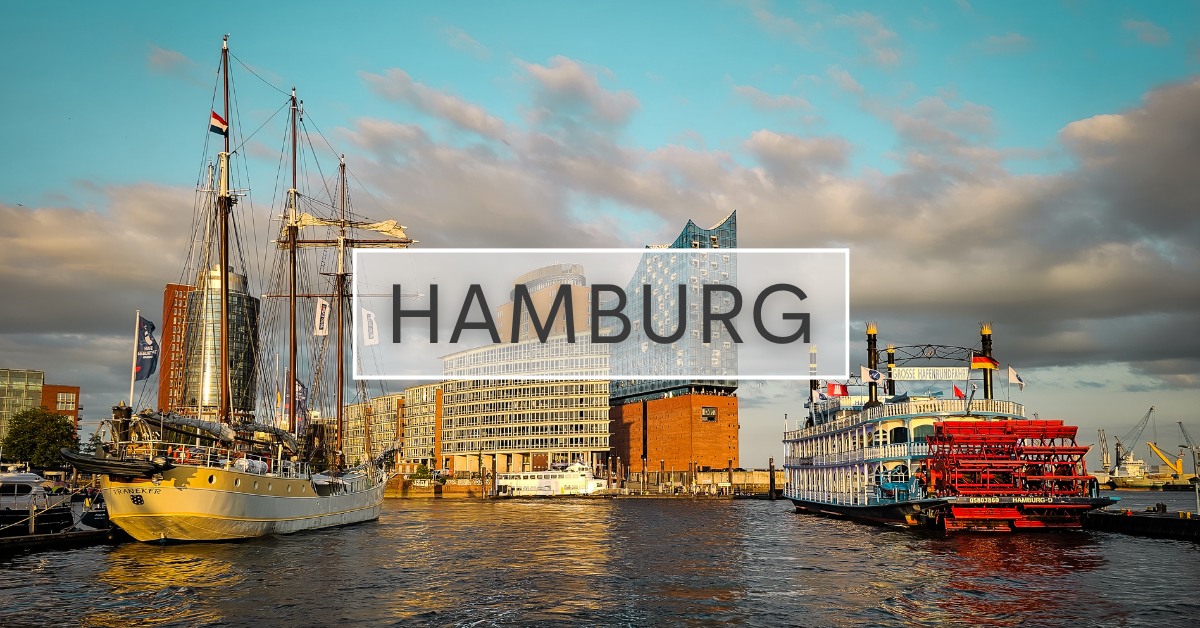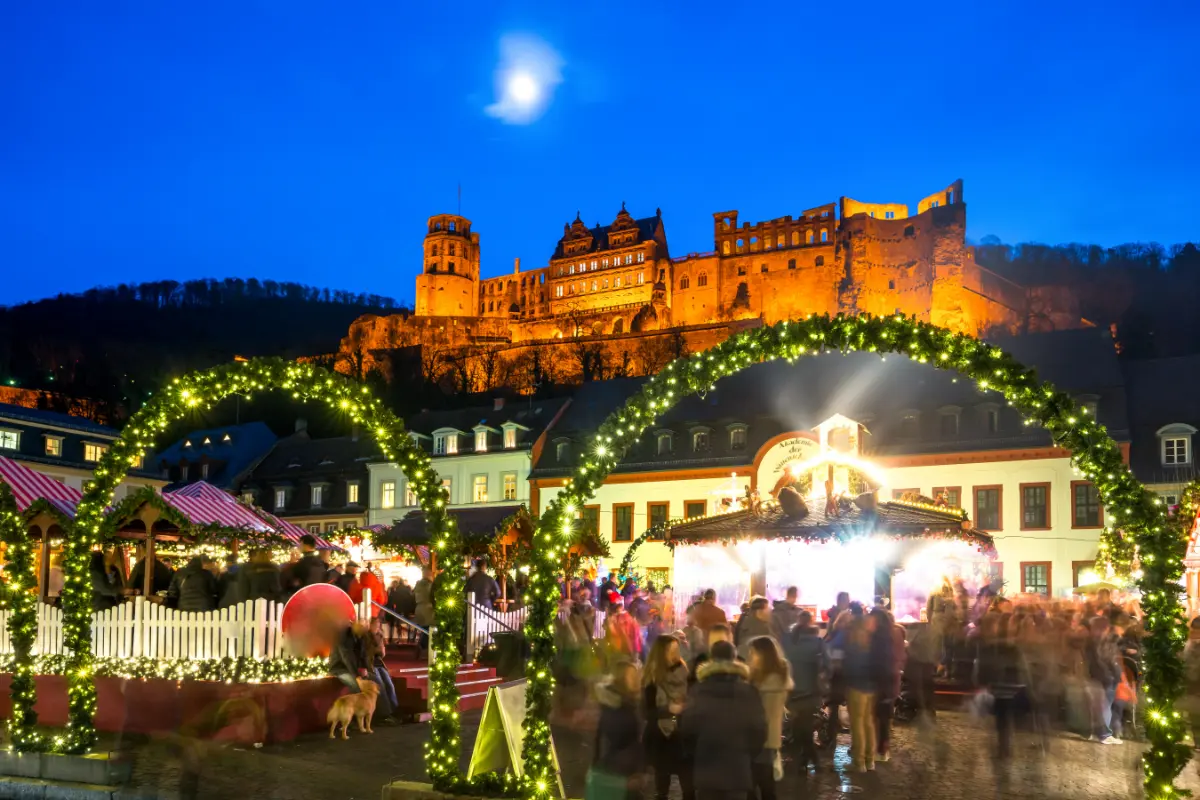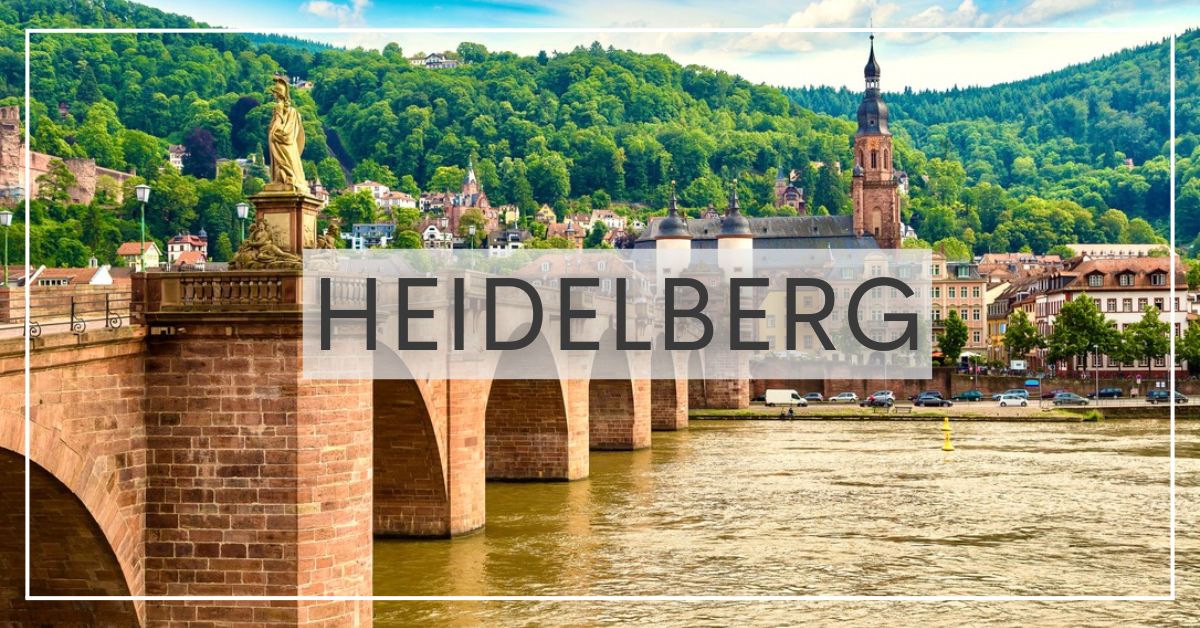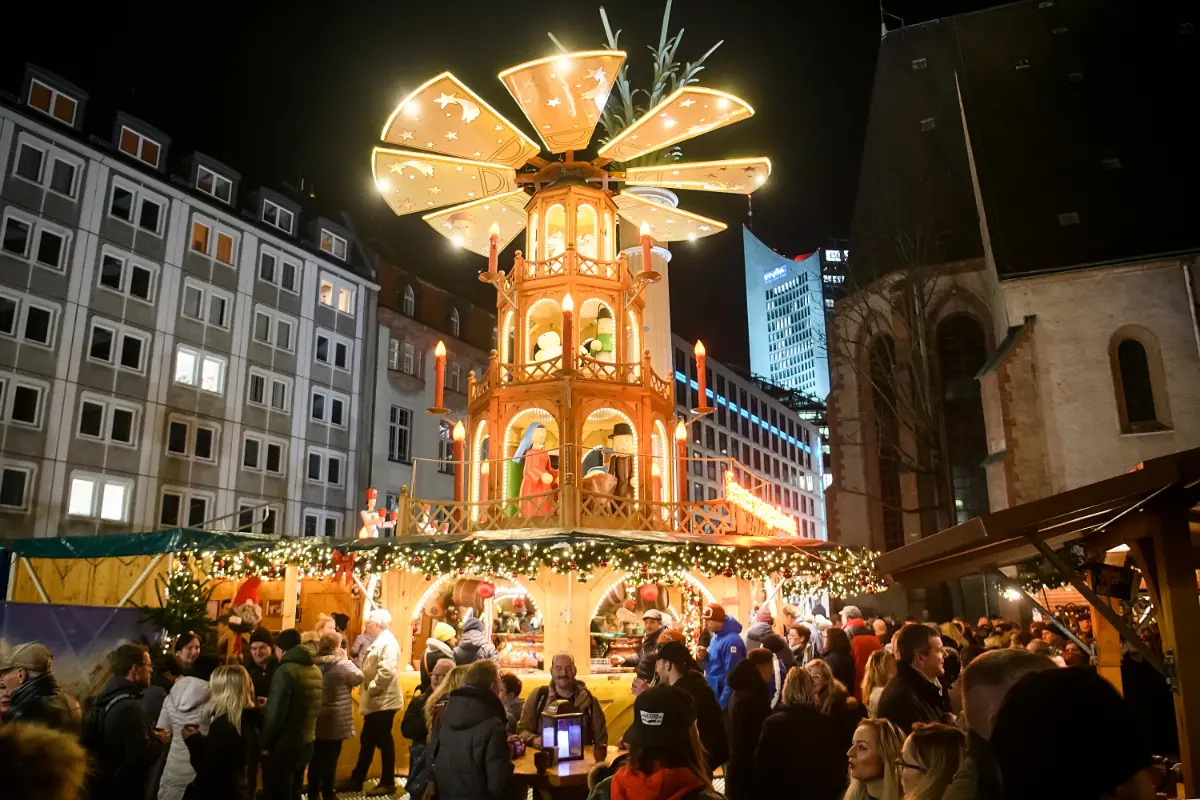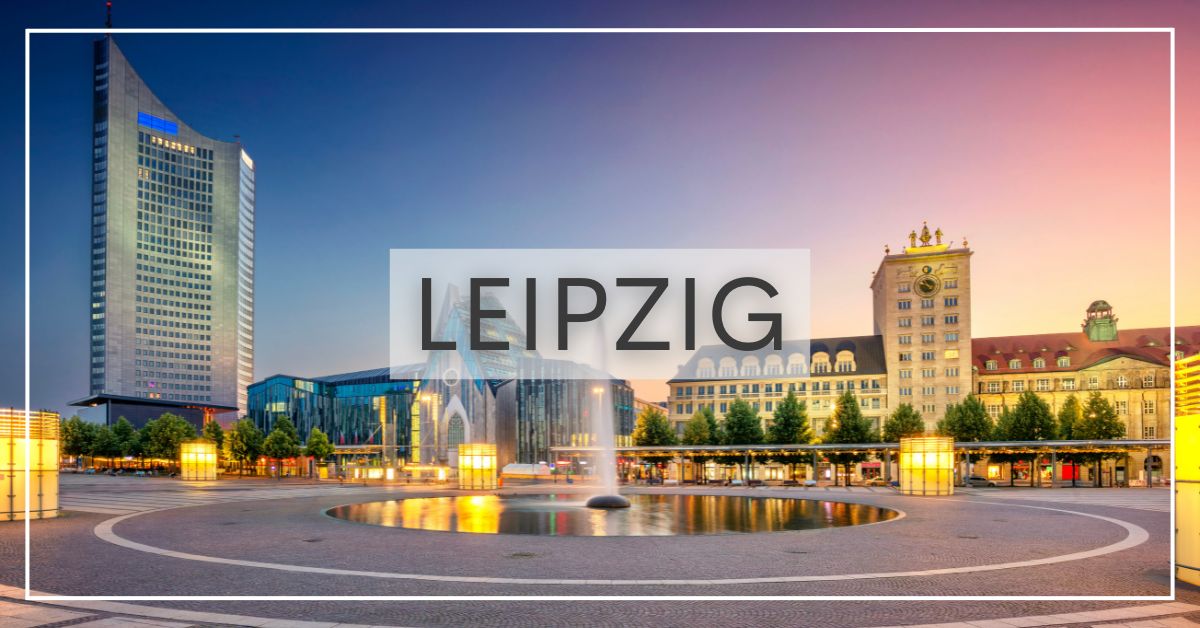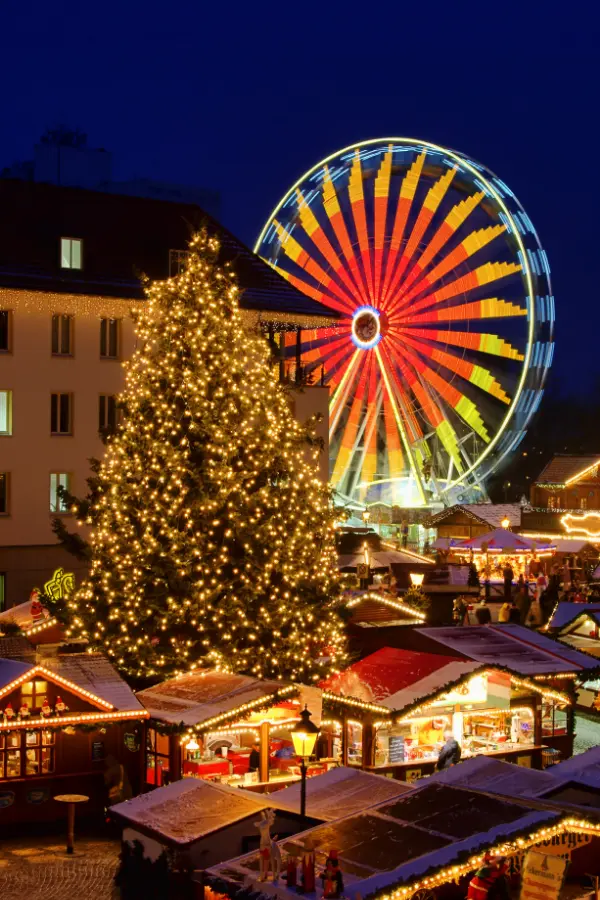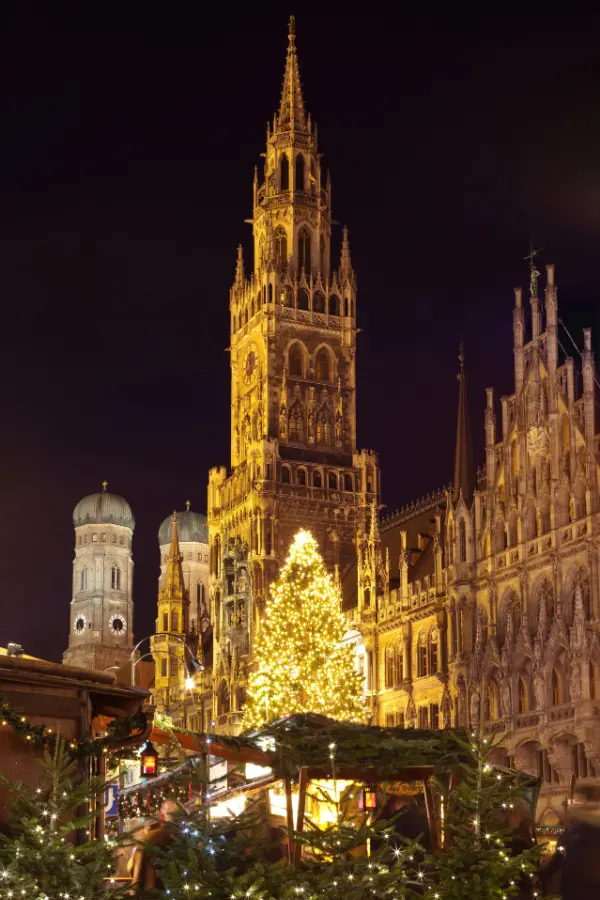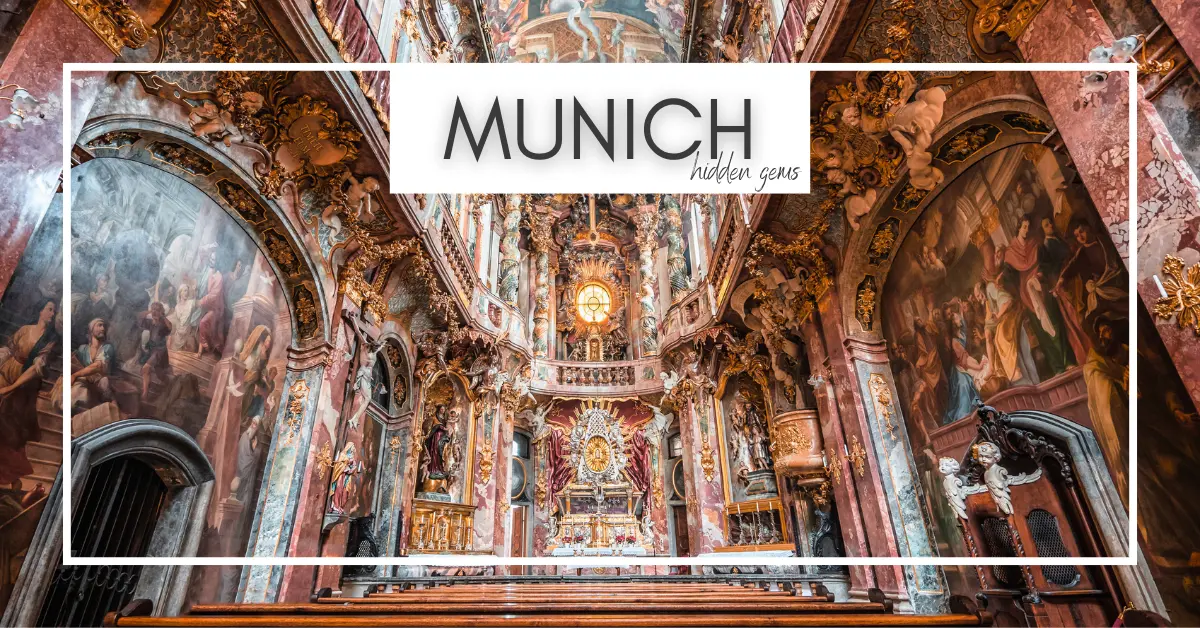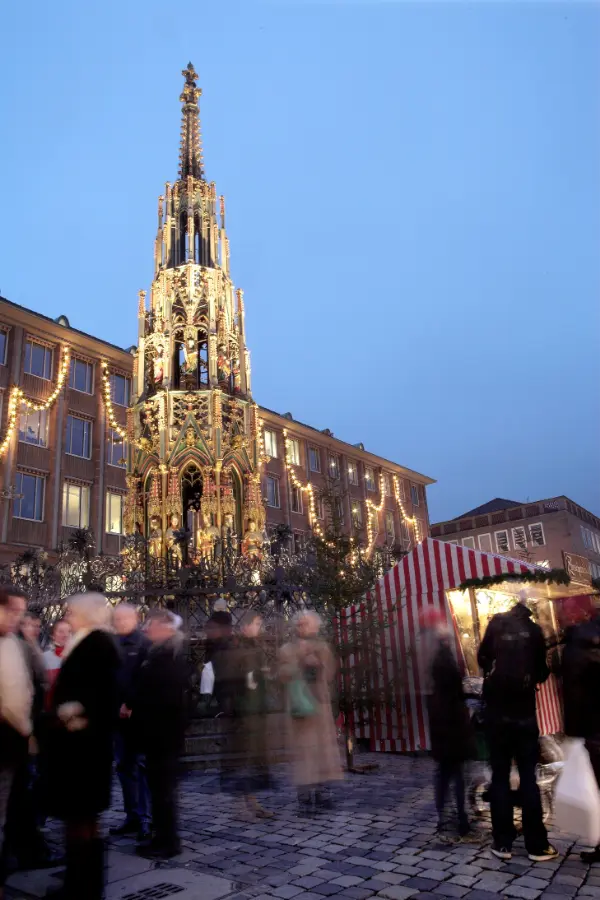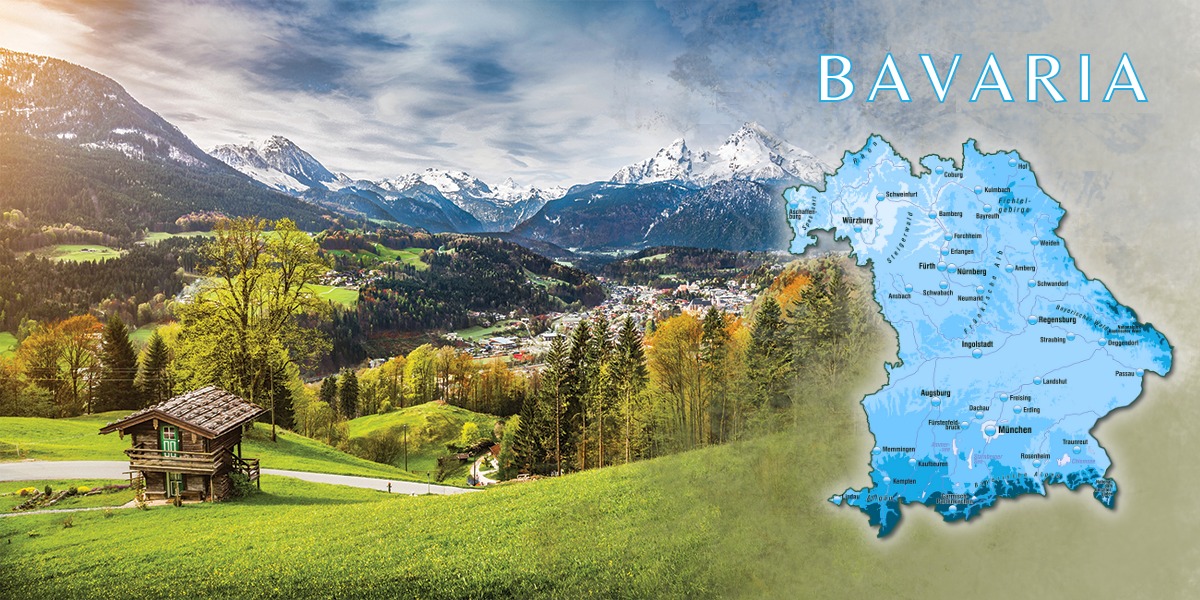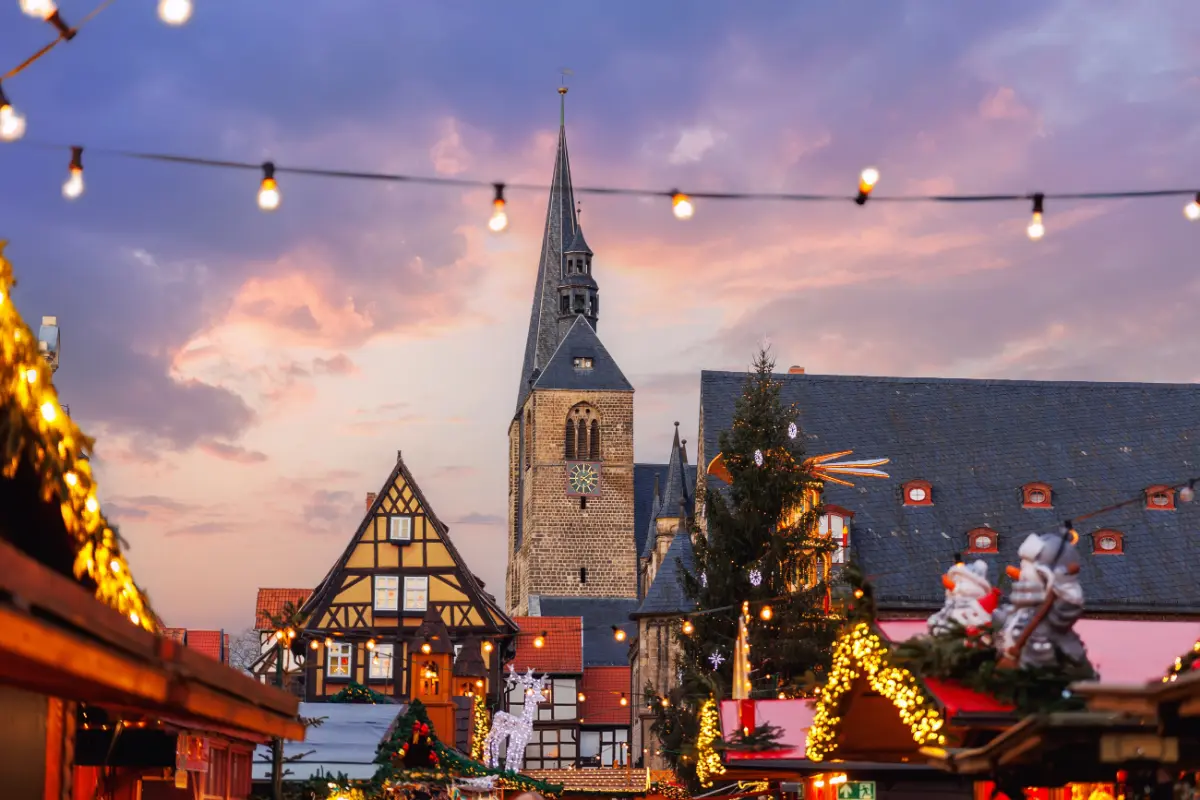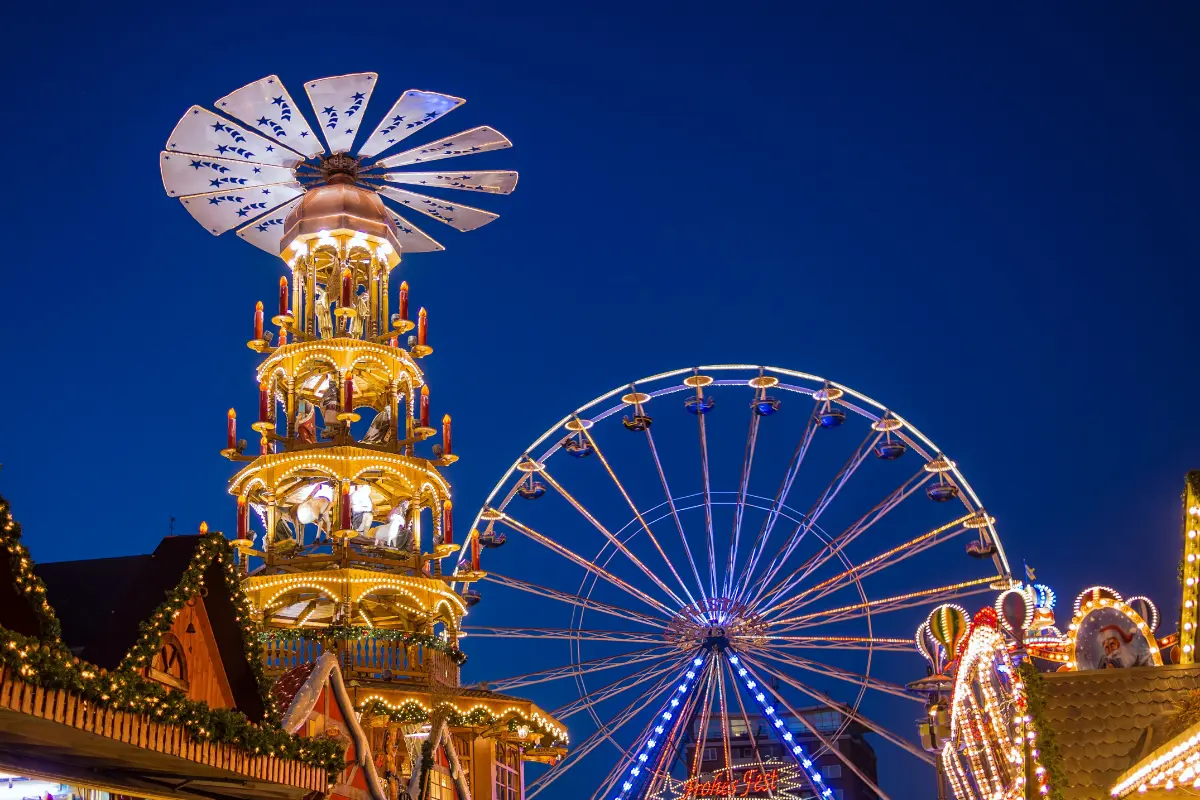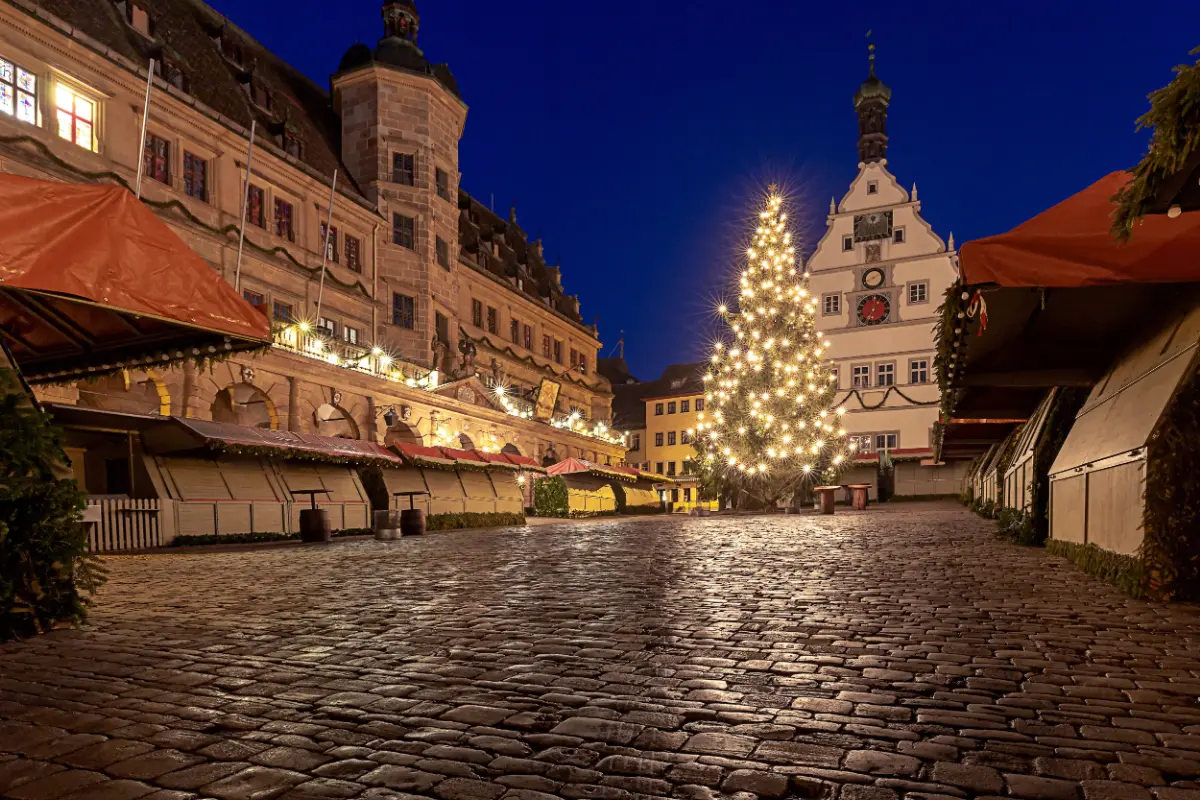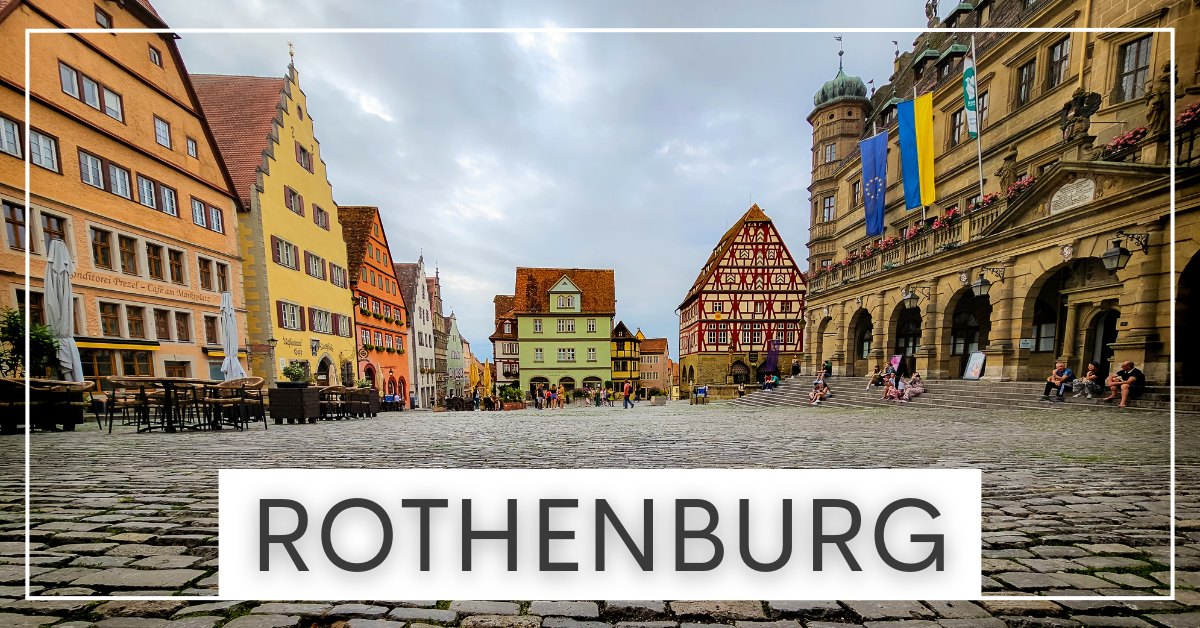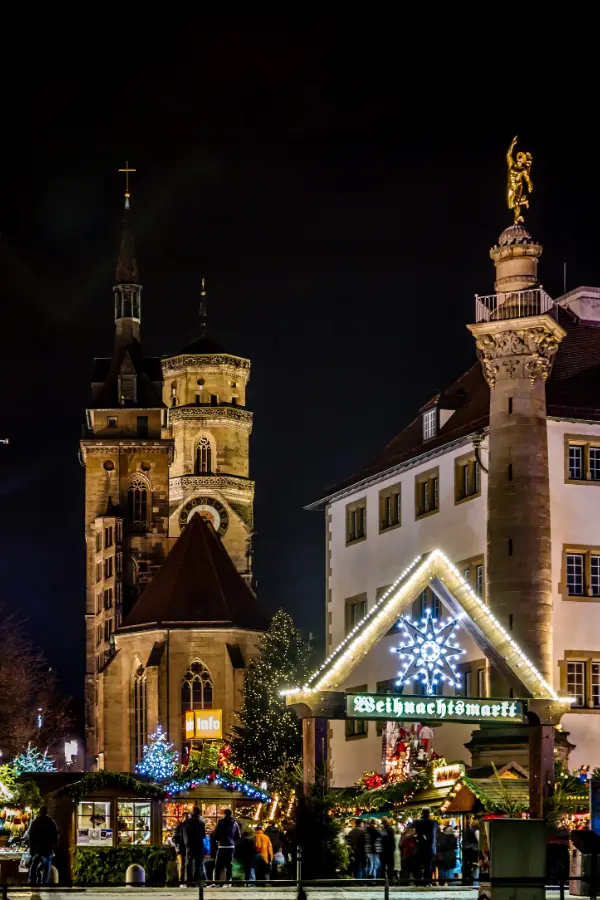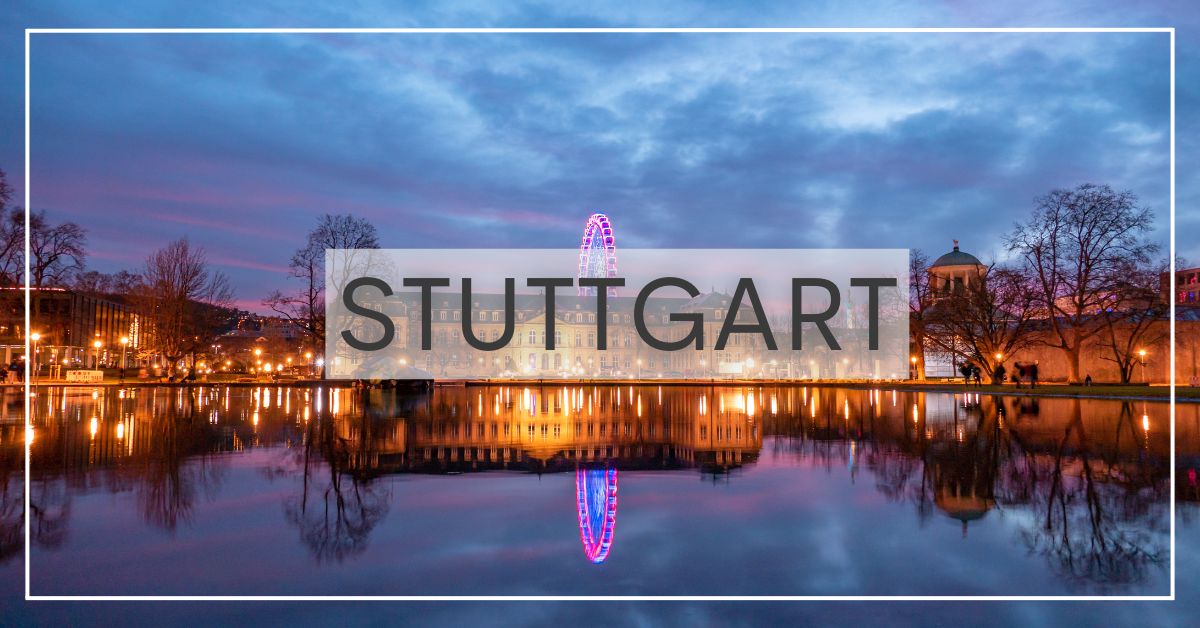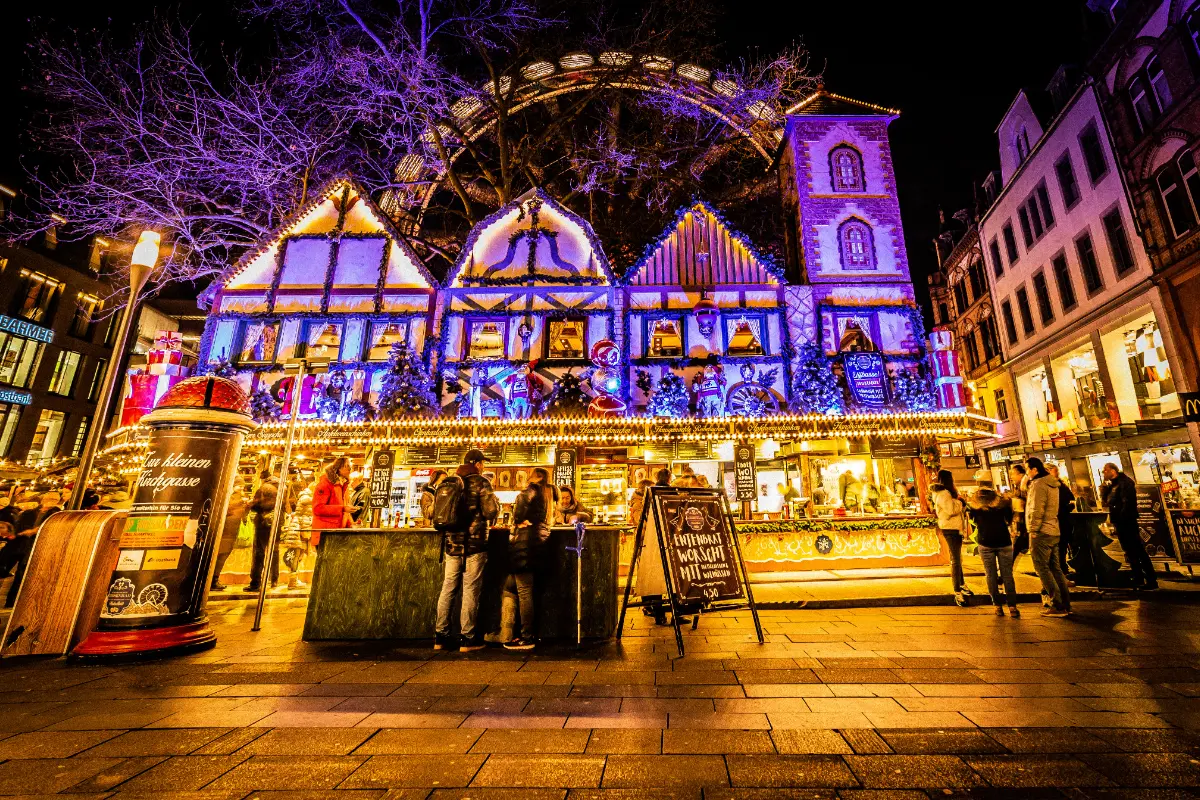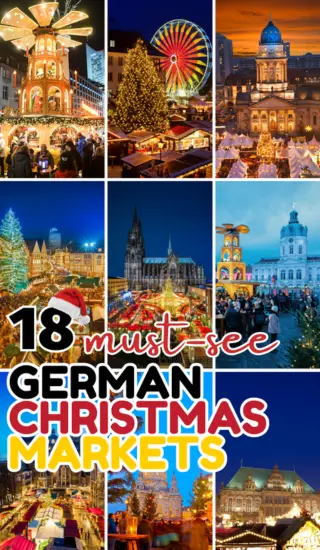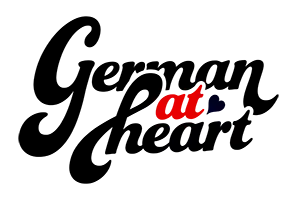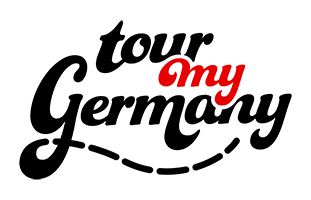- Home
- Christmas Markets
18 German Christmas Markets: The Best to Visit
German Christmas markets are a magical blend of festive cheer, history, and irresistible aromas, making them a must-experience for any holiday traveler. From the twinkling lights and cozy wooden stalls to the scent of mulled wine and gingerbread filling the air, Christmas markets in Germany truly embody the spirit of the season.
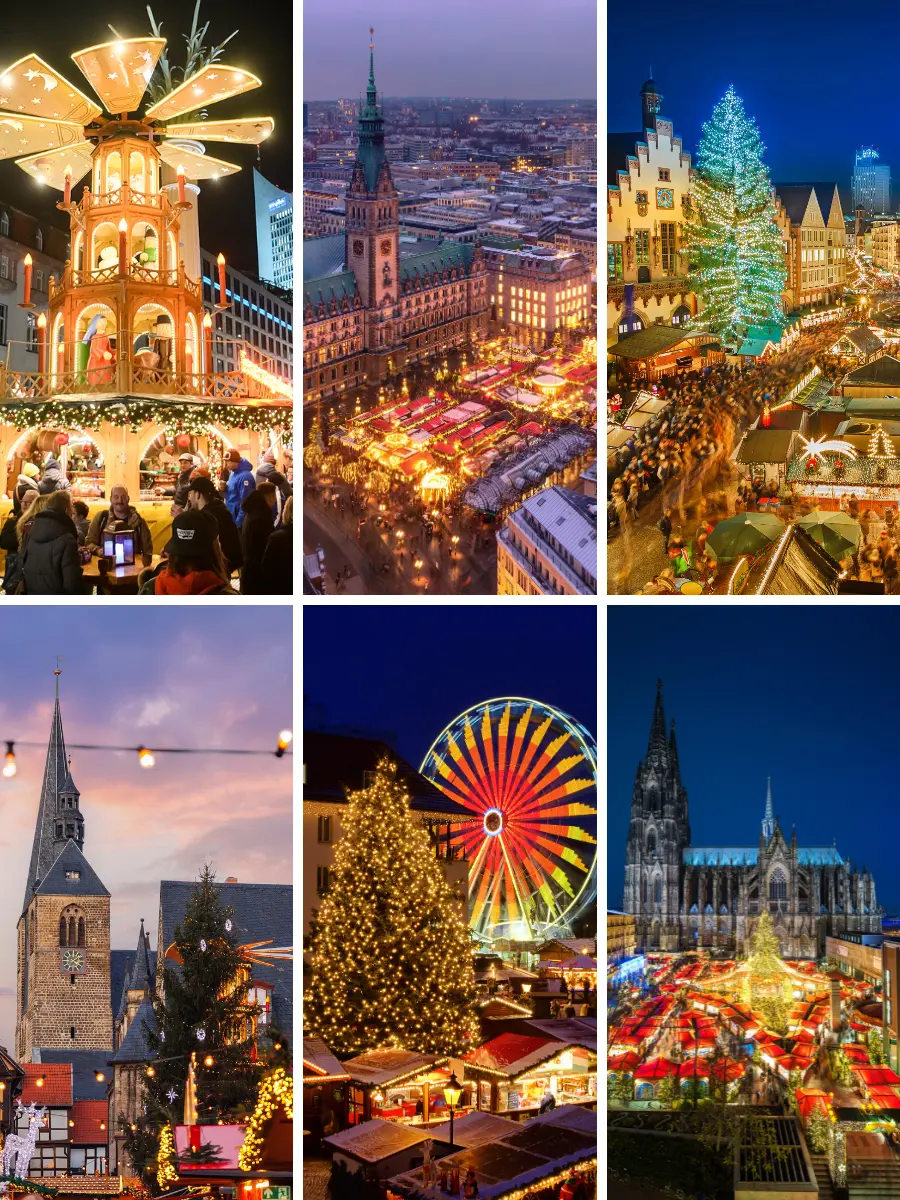
On this page:
Key Takeaways for German Christmas Markets
- A Festive Journey Through Germany's Holiday Heritage: German Christmas markets combine historical charm, festive spirit, and culinary delights, offering visitors a magical holiday experience. Each market showcases unique traditions, from medieval-themed stalls to grand cathedral backdrops, creating an enchanting atmosphere that feels straight out of a fairy tale.
- Taste and Tradition in Every Market: From the iconic Aachener Printen and Nuremberg Lebkuchen to regional specialties like Dresden’s Christstollen and Leipzig’s Leipziger Lerche, every market offers a chance to savor local flavors. Pair these treats with seasonal drinks like Glühwein or Feuerzangenbowle for a truly festive indulgence.
- Unforgettable Sights and Experiences: Whether it’s the world’s largest Erzgebirge pyramid in Dresden, a historic carousel in Hamburg, or a classical concert at Charlottenburg Palace, these markets blend cultural highlights with holiday magic. Each location offers something memorable, making it hard to pick just one favorite.
1 - Aachen Cathedral Christmas Market
What's it known for, and why should you visit?
The Aachen Cathedral Christmas Market, a.k.a. Aachener Weihnachtsmarkt, is set against the breathtaking backdrop of the Aachen Cathedral and Town Hall. It's like they gift-wrapped history in twinkling lights and charming wooden stalls, all designed to make you feel festive—even if you’re generally unmoved by fairy lights.
What are the unique, standout attractions?
If you're into locally crafted goodies, this market has you covered with handmade ornaments and artisanal candles galore. Each stall is practically screaming “unique, one-of-a-kind souvenirs,” even if your carry-on begs to differ.
What traditional or unique culinaries should you try?
Don’t leave without sampling the Aachener Printen, a gingerbread that puts your standard cookie to shame. Pair it with Glühwein (mulled wine) to keep yourself toasty and give in to the local tradition of sugar-induced holiday cheer.
How to capture the market's true atmosphere?
For peak holiday magic, take a stroll through the market as the sun sets. Between the glowing cathedral and the scent of roasted chestnuts, you might just catch yourself believing in Christmas spirit.
2 - Bremen Town Square Market
What's it known for, and why should you visit?
Bremen’s Christmas Market is all about that iconic historic square, complete with UNESCO-listed sites like the Town Hall and Roland statue. Toss in the maritime vibes of Schlachte-Zauber along the Weser River, and you've got yourself a festive cocktail of history and holiday cheer.
What are the unique, standout attractions?
The Schlachte-Zauber is a medieval twist on the classic Christmas market, complete with historical ships and blue lights reflecting off the Weser. It’s like a holiday market met a renaissance fair, and they became best friends.
What traditional or unique culinaries should you try?
You’re in Bremen, so go for Kluten (peppermint chocolates) and smoked fish for that nautical touch. Pair with Feuerzangenbowle, a flaming punch that sounds like something you'd need a fire extinguisher for but tastes a lot better.
How to capture the market's true atmosphere?
Take a wander through the historic center around the Town Hall and Roland statue. Catch a live performance, and let the festive tunes work their magic on you.
3 - Charlottenburg Palace Market (Berlin)
What's it known for, and why should you visit?
Charlottenburg Palace becomes a literal palace of lights during the holidays, making this market feel more like stepping into a fairy tale than reality. Even the Grinch would be impressed.
What are the unique, standout attractions?
High-quality crafts and global goods meet a kids’ area with a carousel, so there’s a little something for everyone. Parents can shop without complaints, kids can carousel. Win-win.
What traditional or unique culinaries should you try?
Don’t skip the Berliner Pfannkuchen (Berlin-style doughnuts). Wash it down with hot Glühwein for the full Berlin holiday experience—no, it’s not a doughnut and wine pairing, but who’s judging?
How to capture the market's true atmosphere?
Catch a classical concert in the palace. It’s about as “holiday spirit” as you can get without breaking into carols yourself.
4 - Cologne Cathedral Christmas Market
What's it known for, and why should you visit?
Situated in front of the towering Cologne Cathedral, this market is a holiday selfie dream. It’s festive, central, and the tree here is likely bigger than anything you've seen in your own living room.
What are the unique, standout attractions?
The live music lineup here is next-level, offering everything from carols to jazz. Plus, artisans bring their A-game with handmade goods that make perfect gifts for those people who “already have everything.”
What traditional or unique culinaries should you try?
Try the Reibekuchen (potato pancakes with applesauce) for a local twist on classic comfort food. And, of course, sip some Kölsch, because it’s practically a rule in Cologne.
How to capture the market's true atmosphere?
Hop on the historic carousel for that perfect dose of holiday nostalgia. Great for kids—or anyone who wants to feel like one again.
5 - Dresden Striezelmarkt
What's it known for, and why should you visit?
The oldest of German Christmas markets, dating back to 1434, the Dresden Striezelmarkt is holiday history at its finest. If you’re chasing the “authentic” festive vibe, you’ll find it here.
What are the unique, standout attractions?
Behold the world’s largest Erzgebirge step pyramid, towering at over 14 meters. It’s the kind of holiday display that says, “We take Christmas seriously around here.”
What traditional or unique culinaries should you try?
The Original Dresdner Christstollen (fruitcake) is a must. Pair it with a cup of mulled wine, and you’re officially tasting tradition.
How to capture the market's true atmosphere?
Make sure to catch the Stollen Festival. Yes, it’s a parade for fruitcake, and yes, it’s as festive as it sounds.
6 - Frankfurt Römerberg Christmas Market
What's it known for, and why should you visit?
The Frankfurt Christmas Market sprawls across Römerberg and St. Paul’s Square, surrounded by scenic historic buildings and a seriously festive atmosphere. With a 30-meter Christmas tree to boot, it’s hard not to feel the holiday spirit here—even if you’re a skeptic.
What are the unique, standout attractions?
There’s the giant Christmas tree, but don’t overlook the carousel and live balcony concerts from St. Nicholas Church. Nothing says “season’s greetings” quite like being serenaded by a choir from above.
What traditional or unique culinaries should you try?
For a sweet bite, go for Bethmännchen, a Frankfurt classic made of marzipan. Wash it down with Ebbelwei (apple wine), served warm to ward off the winter chill.
How to capture the market's true atmosphere?
Take a spin on the historic carousel or climb St. Nicholas Church for views of the entire festive scene—think of it as your ultimate Christmas card photo op.
7 - Gendarmenmarkt Christmas Market (Berlin)
What's it known for, and why should you visit?
Nestled between the German and French Cathedrals, Gendarmenmarkt is Berlin’s most sophisticated Christmas market. Here, holiday elegance meets high-quality artisanal finds, perfect for anyone trying to holiday-shop without the kitsch.
What are the unique, standout attractions?
Artisans show off their talents in a heated tent, where you’ll see everything from wood carving to glassblowing. It’s like watching a craft show but with actual snow and seasonal treats.
What traditional or unique culinaries should you try?
Grab a Flammkuchen (think thin-crust pizza with crème fraîche, onions, and bacon), and pair it with a hot Feuerzangenbowle—a drink with a flaming sugar cube. Just don’t burn your tongue.
How to capture the market's true atmosphere?
Catch a live performance, whether it’s a choir or jazz band. There’s nothing like festive music to make even the biggest Scrooge smile.
8 - Hamburg Town Hall Market
What's it known for, and why should you visit?
Right in front of the Hamburg Town Hall, this market combines classic holiday charm with a touch of maritime flair. It’s the ultimate holiday experience for those who like their Christmas with a side of harbor vibes.
What are the unique, standout attractions?
Check out the historic carousel—it’s all the nostalgia you need, whether you’re young or just young at heart. You’ll also find quirky maritime-themed stalls that scream “Hamburg Christmas.”
What traditional or unique culinaries should you try?
Try the Franzbrötchen, a cinnamon roll-like pastry that’s a Hamburg favorite. Wash it down with Sanddorn punch (made from sea buckthorn berries) for something local and sweet.
How to capture the market's true atmosphere?
Take a boat tour of the harbor, which is usually decked out in lights. There’s nothing like seeing Hamburg all festive from the water.
9 - Heidelberg Old Town Christmas Market
What's it known for, and why should you visit?
Set against the magical Heidelberg Castle, this market practically oozes romance. If you’re in search of charm and holiday magic, look no further.
What are the unique, standout attractions?
The ice rink at Karlsplatz square lets you skate with a view of the illuminated castle—talk about setting the scene. It’s basically your holiday postcard come to life.
What traditional or unique culinaries should you try?
Heidelberger Studentenkuß, a chocolate praline, is a local sweet treat that won’t disappoint. Pair it with a regional Glühwein to sip and savor in true Heidelberg style.
How to capture the market's true atmosphere?
Hop on the funicular up to the castle for views of the market and city all dressed up for the holidays. You’ll feel like you’re in a snow globe.
10 - Leipzig Christmas Market
What's it known for, and why should you visit?
Leipzig’s market is one of Germany’s oldest, with over 250 stalls filling the historic city center. If you’re after holiday traditions and a dose of history, this is the place.
What are the unique, standout attractions?
The Finnish Village on Augustusplatz brings a bit of Finland to Germany, with Finnish treats, crafts, and even a sauna if you’re feeling brave. Plus, there’s a massive Advent calendar on the Old Town Hall that opens daily—your inner child will love it.
What traditional or unique culinaries should you try?
Sample the Leipziger Lerche, a shortcrust pastry with nuts, almonds, and a cherry on top. Pair it with Glühwein or Leipzig’s own Gose beer for an authentic taste of the city.
How to capture the market's true atmosphere?
Catch a performance by the St. Thomas Boys Choir—it’s festive and traditional and just might make you feel a little bit emotional.
11 - Magdeburg Christmas Market
What's it known for, and why should you visit?
This market is super family-friendly, with a strong lineup of entertainment for kids and adults alike. Magdeburg goes all out to make sure even the littlest holiday-goers have a good time.
What are the unique, standout attractions?
The fairytale forest here is pure holiday whimsy, with life-size displays of classic stories. You don’t need kids as an excuse to stroll through—just own it.
What traditional or unique culinaries should you try?
Try the Magdeburger Schmalzkuchen, little fried dough nuggets that are practically made for eating by the handful. A hot chocolate topped with whipped cream is the perfect way to wash them down.
How to capture the market's true atmosphere?
Take in one of the daily puppet shows. It’s cozy, festive, and a throwback to simpler holiday times.
12 - Munich Christkindlmarkt
What's it known for, and why should you visit?
Marienplatz is Munich’s holiday heart, complete with Bavarian charm and a stunning Neo-Gothic town hall backdrop. This market is as quintessentially Bavarian as it gets.
What are the unique, standout attractions?
The Kripperlmarkt is Munich’s take on a nativity market, with hand-carved figures that add a traditional twist. Add in daily performances of Alpine Christmas music, and it’s pure Bavarian holiday magic.
What traditional or unique culinaries should you try?
The Weißwurst (white sausage) with mustard and pretzels is a must, especially if you’re new to Bavarian fare. For something sweet, roasted chestnuts and gingerbread hearts do the trick.
How to capture the market's true atmosphere?
Browse the Kripperlmarkt or stand in Marienplatz to take in the holiday lights and live music. You’ll feel like you’ve stepped into a Bavarian holiday story.
13 - Nuremberg Christkindlesmarkt
What's it known for, and why should you visit?
The Nuremberg Christkindlesmarkt is one of the Grandaddy's of German Christmas markets. Dating back to the 16th century, it’s one of the oldest and most famous, making it a non-negotiable stop for anyone craving an authentic festive experience.
What are the unique, standout attractions?
The “Christkind” herself, Nuremberg’s festive ambassador, opens the market with a prologue and makes appearances throughout the season. It’s the holiday equivalent of a celebrity sighting but with way more sparkle.
What traditional or unique culinaries should you try?
Grab some Lebkuchen (Nuremberg gingerbread) and a Nürnberger Rostbratwurst (the city’s famous sausage, served three-in-a-bun style). It’s holiday calorie stuffing at its finest.
How to capture the market's true atmosphere?
Stroll through the “Market of the Sister Cities” for a little global flair amid the traditional stalls. It’s the perfect blend of local charm and international holiday spirit.
14 - Quedlinburg Advent Market
What's it known for, and why should you visit?
Set within a UNESCO World Heritage town, Quedlinburg’s Christmas market has a unique medieval vibe that makes you feel like you’ve time-traveled to a fairy-tale village. A market this quaint deserves at least a few hours of wandering.
What are the unique, standout attractions?
The “Advent in the Courtyards” is something truly special, as private courtyards open to the public, each uniquely decorated and brimming with festive treats and crafts. It’s like a holiday open house, but way more charming.
What traditional or unique culinaries should you try?
Quedlinburger Baumkuchen, a layered “tree cake,” is the sweet treat of choice here. Pair it with hot mead to really embrace the medieval vibes.
How to capture the market's true atmosphere?
Take a guided evening tour of the historic center, where festive lights and a bit of history combine to make it an unforgettable holiday experience.
15 - Rostock Christmas Market
What's it known for, and why should you visit?
As the largest German Christmas market in the north, Rostock brings a maritime twist to the holiday season. If you’re dreaming of a festive scene by the sea, this is where you want to be.
What are the unique, standout attractions?
The medieval market area is a standout, with artisans showing off their skills and a few historical reenactments thrown in for good measure. It’s a little bit of history with your holiday shopping.
What traditional or unique culinaries should you try?
Rostocker Rauchwurst, a smoky sausage that’s packed with flavor, is the local snack of choice. And don’t skip the Sanddorn Glühwein, a mulled wine made from sea buckthorn berries for a taste of the North Sea.
How to capture the market's true atmosphere?
Take a ride on the Ferris wheel for sweeping views of the market and city center. It’s the best way to appreciate Rostock’s holiday glow from above.
16 - Rothenburg ob der Tauber Reiterlesmarkt
What's it known for, and why should you visit?
The Reiterlesmarkt in Rothenburg ob der Tauber is as storybook as it gets, set in a perfectly preserved medieval town. If you’re after the ultimate fairy-tale Christmas, this is it.
What are the unique, standout attractions?
The market is graced by the appearance of the “Rothenburger Reiterle,” a mythical figure who wanders the market, adding a mystical layer to the festivities. It’s like Santa but with a bit of German folklore magic.
What traditional or unique culinaries should you try?
Schneeballen (snowballs), a pastry made of fried dough and dusted with powdered sugar, is the local sweet treat. Wash it down with a glass of white mulled wine—a regional twist on the classic red.
How to capture the market's true atmosphere?
Wander along the medieval walls and towers, which are illuminated for the season. It’s the perfect way to feel transported to another era while soaking in the holiday charm.
17 - Stuttgart Christmas Market
What's it known for, and why should you visit?
Stuttgart’s Christmas Market is one of the largest in Germany, with over 280 stalls decorated to the nines. If you’re looking for a market that goes big, this is your spot.
What are the unique, standout attractions?
The Finnish Christmas Village brings a taste of Finland to Stuttgart, complete with reindeer and Lappish crafts. It’s like taking a mini holiday within a holiday.
What traditional or unique culinaries should you try?
Maultaschen, Swabian ravioli stuffed with meat, is the savory go-to here. And don’t skip the Eierpunsch, a warm egg-based punch that tastes like a German twist on eggnog.
How to capture the market's true atmosphere?
Catch a concert in the Renaissance courtyard of the Old Palace for an infusion of culture that fits right in with the festive scene.
18 - Wiesbaden Sternschnuppenmarkt
What's it known for, and why should you visit?
The Wiesbaden Sternschnuppenmarkt (Twinkling Star Market) is known for its signature blue and gold illuminations, setting a starry, dreamy tone right in the Schlossplatz. It’s elegance meets holiday spirit.
What are the unique, standout attractions?
The illuminated gates adorned with the Wiesbaden lily create a magical entrance, leading you through stalls full of handcrafted goodies. The historic Ferris wheel and children’s area on Luisenplatz make it fun for all ages.
What traditional or unique culinaries should you try?
Bethmännchen, a local almond pastry, is the star of the snack scene here. Pair it with Heißer Äppler (warm apple wine) for a taste of the region’s Hessian roots.
How to capture the market's true atmosphere?
Hop on the Ferris wheel for panoramic views of the city all lit up for the season. For family vibes, check out the children’s market on Luisenplatz, complete with a light show and carousel for a cheerful holiday experience.
Wrapping Up
German Christmas markets cover a wide swathe of themes and historical surroundings. Arguably, as the years pile on, a degree of commercialization will inevitably begin to seep in. Smaller town markets will generally hold more tightly to their historical roots, while the larger city Christmas markets carry a more all-consuming atmosphere.
Whichever way your preferences lie, you're sure to find a German Christmas market to suit.
And if you're ever unsure, more Glühwein helps.
German Christmas Markets FAQ
Which is the best Christmas market in Germany?
Which is the best Christmas market in Germany?
Germany boasts several globally renowned Christmas markets, but the Nuremberg Christkindlesmarkt consistently stands out as one of the most famous. Known for its historic charm and festive ambiance, it features traditional stalls offering handcrafted goods and the beloved “Lebkuchen” gingerbread.
Visitors also rave about the vibrant market in Munich's Marienplatz and the iconic lights and towering Christmas tree in Berlin's Gendarmenmarkt. Each city brings its unique flavor, making it hard to choose just one “best” market!
What date are the Christmas markets in Germany?
What date are the Christmas markets in Germany?
Most German Christmas markets start at the end of November, typically around the 24th or 25th, and run until Christmas Eve or even into early January in some cities.
Major markets like those in Cologne, Nuremberg, and Dresden tend to open from late November through December.
Each market has its own start and end dates, so it’s best to check specific dates if you plan to visit multiple cities.
Are German Christmas markets worth it?
Are German Christmas markets worth it?
Absolutely! German Christmas markets offer a magical holiday experience filled with local culture, crafts, and seasonal foods like mulled wine (Glühwein), roasted chestnuts, and Bratwurst. They often take place in historic city centers, providing a fairytale-like setting.
Visitors can enjoy concerts, traditional holiday decorations, and sometimes even ice skating. They’re not just worth it—they’re often the highlight of a winter trip to Germany.
Which city has the best Christmas market?
Which city has the best Christmas market?
Nuremberg, Munich, and Cologne each claim top spots when it comes to holiday markets in Germany.
Nuremberg is celebrated for its Christkindlesmarkt, Munich for its stunning Marienplatz setup, and Cologne for the impressive cathedral backdrop.
Meanwhile, Berlin boasts many smaller, artistically unique markets. Every city offers its own distinct charm, so “best” often depends on personal preference and what kind of experience you’re after.
Is Berlin or Munich better for Christmas markets?
Is Berlin or Munich better for Christmas markets?
Both Berlin and Munich have fantastic Christmas markets, though they offer quite different atmospheres.
Berlin has a range of markets, each with its unique flair—some are artsy, some are more traditional, and others are grand with international themes.
Munich, on the other hand, captures a more traditional Bavarian Christmas spirit with its historic Marienplatz market and the Tollwood Winter Festival, which combines art, music, and food in a festive way.
